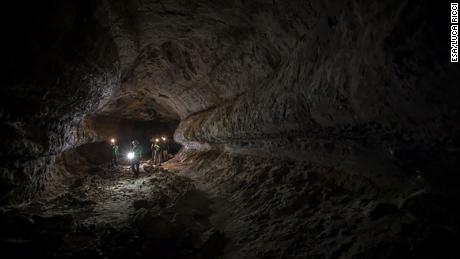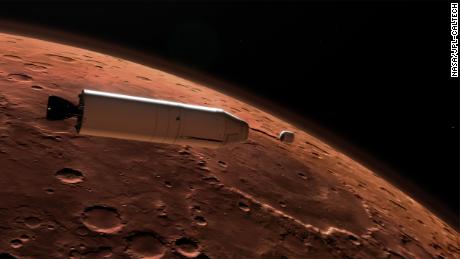(CNN)Lava tubes beneath the surface of Mars and the moon could be, respectively, 100 and 1,000 times wider than lava tubes on Earth, which could provide shelter and create exploration opportunities for astronauts in the future, according to a new study.
Lava tubes are caves created by lava as it flows from a volcanic vent beneath a hardened surface. On Earth, these lava tubes can be found in Hawaii, the Canary Islands, Australia and Iceland. They range in diameter from 33 to 98 feet.
Lunar tubes on the moon and Mars could be longer than 25 miles, according to a new study using satellite images, radar data, spacecraft observations of features called skylights belonging to collapsed lava tubes and digital terrain models of lava tubes on the moon and Mars.
The researchers compared these to lava tubes on Earth and found that lunar caves could reach 1 kilometer in diameter, or 3280.84 feet -- which could accommodate the tallest buildings on Earth.
Lower gravity, and how it effects volcanism, the scientists believe, could explain these exceptionally large tubes.
The lava tubes beneath the moon's surface are so large that they could, in fact, hold Padua's entire city center, said Riccardo Pozzobon, study coauthor and planetary geologist in the department of geosciences of the University of Padua in Italy.
The study published this month in the journal Earth-Science Reviews.
The lava tubes beneath the surface of the moon have also remained largely intact due to low gravity. Any collapsed lava tubes on the moon are likely due to asteroid impacts, the researchers said. And those skylights could actually provide access to the tubes.
These lava tubes could help shelter astronauts, as well as provide new information about the moon and Mars.
"The existence of stable huge voids below the Moon subsurface, potentially accessible through skylights, could change the paradigm on how we approach planetary exploration in terms of mission design, planetary human outposts and scientific research," said Pozzobon and Franceso Sauro, study author and professor in the department of biological, geological and environmental sciences at the University of Bologna.
"Accessing these caves and (analyzing) this type of subsurface environment will present new technological challenges but also could provide unexpected scientific discoveries."
Exploring caves on the moon and Mars
For astronauts exploring the harsh environments and fluctuating temperatures of the moon and Mars, the lava tubes could provide natural shelter from radiation, impacts by micrometeorites and unstable temperatures.
Micrometeorites pose a danger not only to astronauts, but the habitats and life support equipment they'll need on the moon and Mars. The caves could be used to live in and store equipment.
It's even possible that the tubes could provide access to water ice reservoirs, the researchers said.
"But the challenges in order to access these caves and sustain human activity are nonetheless massive," the researchers said.
The caves also present dangers and risks of their own.
The tubes will likely contain boulders, sloping floors and shifting rocky material. If future missions plan to utilize the tubes, cranes or tethered descents may be needed to access the entrances because they're likely to be more like vertical shafts.
"Once below, we should not be too confident to find a flat floor (although it is possible) but instead piles of collapsed boulders from the ceiling or the walls, which are razor-sharp and could harm inflatable modules and spacesuits," the researchers said.
Astronauts would also need to be able to properly illuminate their space because the rocks inside the caves will likely be pitch-black. But power is a precious commodity, especially when traveling to the moon or Mars, so developing the right kind of illumination will be key.
Studying the inside of these caves could reveal what volcanic activity was like on the moon and Mars and when it occurred. What's more, such research could provide key insights about the interior composition of these planetary bodies.
The lava tubes' interiors could also reveal "niches that could be ideal for hosting life (on Mars) or could have preserved signs of past life, not obliterated by the sterilizing and ionizing UV/cosmic radiation that affects the surface and the near subsurface," the scientists said.
Preparing astronauts for the journey
Astronauts preparing to explore such caves would need training in traversing vertically developed environments and cave exploration. These expeditions would also require preparation for the challenges of exploring a natural environment with uneven terrain, sharp rocks, rock falls and other unpredictable hazards, the researchers said.
This would involve training for normal exploration operations and emergency situations as well.
Some of this is already being studied and astronauts are training through the European Space Agency's CAVES and Pangaea programs.
Since 2012, These programs have trained astronauts how to explore underground caves and understand planetary geology, including lava tubes on Lanzarote, one of the Canary Islands.
"So far, 36 astronauts from five space agencies have received training in cave hiking; moreover, six astronauts and four mission and operation specialists have received geological field training," said Jo De Waele, study coauthor and speleologist at the University of Bologna.
Sauro, who is also a speleologist studying caves and the head of the CAVES and Pangaea programs, said the ESA is looking for new technologies that would allow for the future exploration of these caves through the agency's Sysnova platform.
"It is for sure a big challenge, but it is now clear for all space agencies that while we have already a good knowledge of the surface of the Moon, one of the main steps forward for space exploration would be to demonstrate the capability of exploring the subsurface of a planetary body," Sauro said.
The call for ideas from universities and the space industry is seeking new technologies that could be developed to land on the moon and explore lunar caves.
Next, the researchers want to learn more about these tubes, including the creation of 3D laser scans and understanding their chemistry.
"When we (have) a figure of their subsurface development through remote sensing, then we will be able to provide the most promising targets for future space robotic or human mission to start the exploration of these features," the researchers said.













